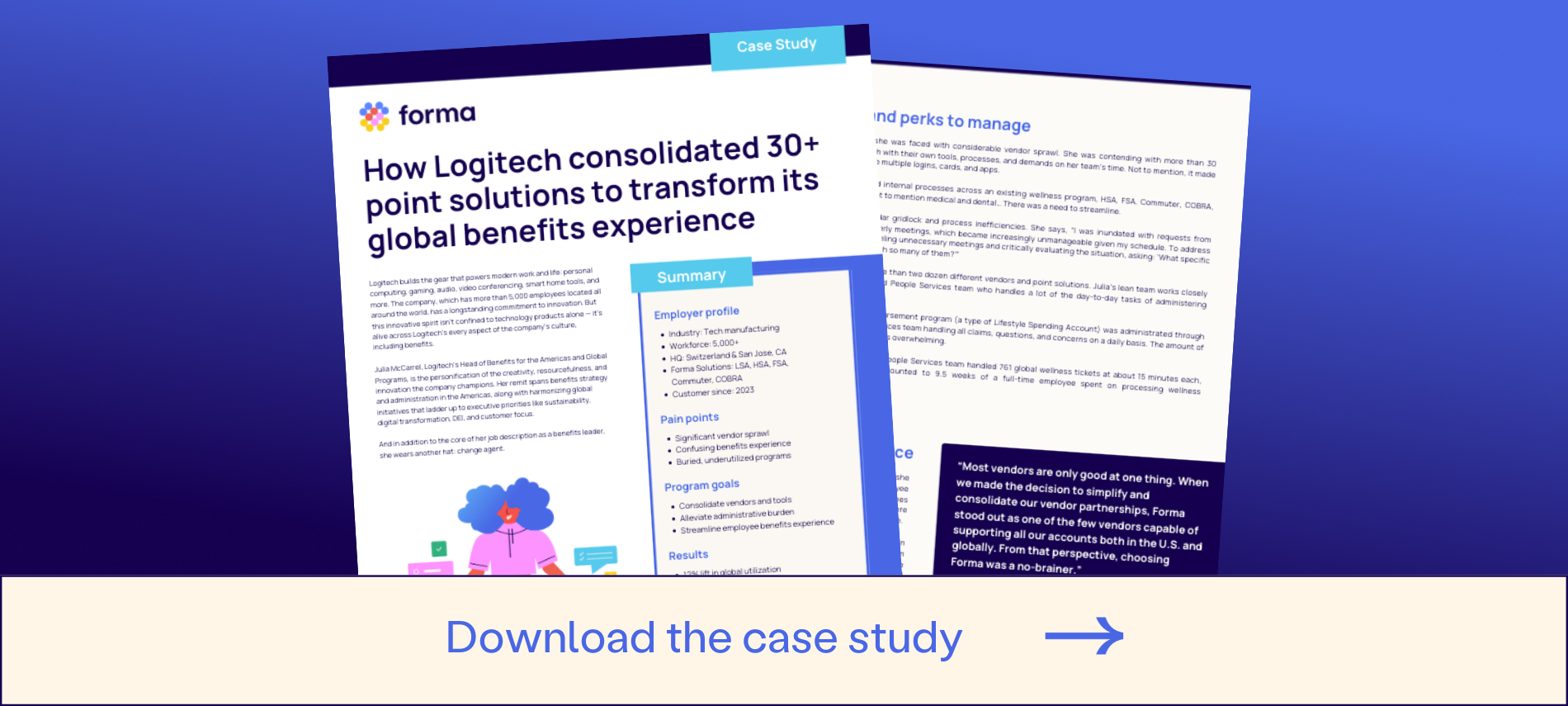
How Logitech consolidated 30+ point solutions to transform its global benefits experience
See how Logitech consolidated 30+ vendors with Forma’s Lifestyle Spending Accounts — saving 9.5 weeks of admin time while boosting benefit utilization by 12%.
In this piece
Logitech builds the gear that powers modern work and life: personal computing, gaming, audio, video conferencing, smart home tools, and more. The company, which has more than 5,000 employees located all around the world, has a longstanding commitment to innovation. But this innovative spirit isn’t confined to technology products alone — it’s alive across every aspect of the company’s culture, including benefits.
Julia McCarrel, Logitech’s Head of Benefits for the Americas and Global Programs, is the personification of the creativity, resourcefulness, and innovation the company champions. Her remit spans benefits strategy and administration in the Americas, along with harmonizing global initiatives that ladder up to executive priorities like sustainability, digital transformation, DEI, and customer focus.
And in addition to the core of her job description as a benefits leader, she wears another hat: change agent.

The before: 30+ benefits vendors and perks to manage
When Julia stepped into her role at Logitech, she was faced with considerable vendor sprawl. She was contending with more than 30 different point solutions, vendors, and perks, each with their own tools, processes, and demands on her team’s time. Not to mention, it made for a challenging employee experience to navigate multiple logins, cards, and apps.
Back in 2022, Logitech had separate vendors and internal processes across an existing wellness program, HSA, FSA, Commuter, COBRA, tuition reimbursement, adoption and surrogacy, not to mention medical and dental… There was a need to streamline.
For Julia, managing various vendors meant calendar gridlock and process inefficiencies. She says, “I was inundated with requests from vendors for weekly calls, monthly syncs, and quarterly meetings, which became increasingly unmanageable given my schedule. To address this, I began streamlining my commitments by canceling unnecessary meetings and critically evaluating the situation, asking: 'What specific roles do these vendors fulfill, and why do we work with so many of them?’”
Julia wasn’t alone in her challenges of managing more than two dozen different vendors and point solutions. Julia’s lean team works closely with Logitech’s shared services group, a centralized People Services team who handles a lot of the day-to-day tasks of administering benefits programs.
For example, the company’s previous Wellness reimbursement program (a type of Lifestyle Spending Account) was administrated through an HRIS system, with Logitech’s People Services team handling all claims, questions, and concerns on a daily basis. The amount of time spent managing just this one wellness program was overwhelming.
As Julia shares, in one six-month window, Logitech’s People Services team handled 761 global wellness tickets at about 15 minutes each, which annualized to 380 hours. Essentially, this amounted to 9.5 weeks of a full-time employee spent on processing wellness reimbursements alone.
A need to enhance the employee benefits experience
In addition to the challenges Julia and her team were facing, she knew she needed to make a change to improve the employee experience. The current setup caused confusion for employees trying to access their benefits, and some offerings were “buried” because they were hard for people to find and use.
Many of the existing vendors’ point solutions and platforms in place were, as Julia puts it, “archaic.” In her view, the systems in place weren’t up to modern technological standards, because they lacked strong customer support, a user-friendly look and feel, and options like AI-enabled messaging services.
Her own personal experience echoed the same sentiment. “When I started, I was thinking, ‘I’m managing these programs, and even I think this is confusing.’ If I were an employee, I would be even more confused.”
.png)
Making the decision to move to Forma
As an innovator and a change agent, Julia knew what to do: it was time to streamline and consolidate.
Julia wanted one place that could handle lifestyle benefits and the complex, compliance-heavy pre-tax world. She needed to solve for the administrative burden and confusing employee experience, with five key objectives:
- Enhance employee wellness, reduce stress-related burnout, and increase energy by offering a stipend to facilitate access to fitness programs, memberships, mindfulness apps, etc.
- Increase employee productivity and focus and minimize absenteeism by investing in what employees truly need.
- Attract and retain talent by offering personalized benefits to support the workforce’s unique needs.
- Foster equity and inclusion globally with a wellbeing stipend that ensures diverse demographics and lifestyles are accommodated.
- Reduce healthcare costs and lower incidents of chronic illness by supporting preventative care, promoting physical activity, and encouraging healthy living.
Having worked with Forma in a previous role — “We implemented and found that Forma thought the same way we did about benefits, plus employees loved the program” — Julia knew that Forma’s customizable spending accounts platform would be the right match for what Logitech needed.
“Most vendors are only good at one thing. When we made the decision to simplify and consolidate our vendor partnerships, Forma stood out as one of the few vendors capable of supporting all our accounts both in the U.S. and globally,” Julia explains. “From that perspective, choosing Forma was a no-brainer.”
Designing and implementing flexible, personalized programs
After it was decided within HR/Benefits that Logitech wanted to implement Forma to streamline platforms and improve the employee experience, Julia needed to convince other stakeholders:
- Get the Executive team on board to secure funding by communicating how the LSA approach supported Logitech’s broader organizational goals.
- Convince Finance and Procurement teams by sharing a transparent cost model and predictability of spend and demonstrating potential cost savings by bundling all wellness programs into one platform.
- Prove to Legal and Compliance that the program would be legal and compliant across all 43 countries.
Throughout the process, Julia felt supported by the Forma team. “Luckily, Forma has valuable benchmark data on what their other clients do, and a great compliance team that is able to offer guidance. This helped to make decisions internally that were best for Logitech,” she explains.
Consolidating vendors and launching LSAs with Forma
Initially, Logitech implemented Forma with three customizable spending accounts that were pulled in from other vendors or manual workflows:
Global Wellness LSA
- This large-scale program is offered in 43 countries, covering fitness memberships and classes, athletic gear and wearables, mindfulness apps, and more. Employees can choose to spend their funds using claims reimbursements and/or the global Forma Store.
Adoption and surrogacy support (U.S.):
- Logitech also created an adoption and surrogacy wallet in Forma to centralize details that were previously buried on the company’s intranet.
Tuition reimbursement (U.S. and Canada):
- Logitech migrated this formerly underutilized program to a Forma wallet for better visibility and consistency, with no more manual intake through People Services and payroll.
In addition to the time savings for herself and her teams, Julia saw an exciting result emerge: a 12% lift in utilization of the global LSA after moving to Forma.
“By moving to Forma, we not only freed up valuable time for our internal teams but also enhanced the employee experience. Our workforce was particularly enthusiastic about the Forma Store, which provided them with a streamlined and user-friendly platform,” she says.
Bringing pre-tax and more benefits into the Forma platform
After the LSAs were in place, Julia brought additional benefit programs onto Forma, consolidating what used to live with multiple “old-school” vendors.
Julia paints a picture with her own personal experience. “With our previous vendor for FSA, I had to reach out to my rep because I couldn’t figure out how to submit my own dependent care FSA claim. It was mortifying,” she says. “I own this program, and I can’t figure it out. How must our employees feel?”
That personal experience made Julia even more confident about moving more benefits into the intuitive Forma platform.
"We had already decided to transition to Forma for managing other pre-tax accounts, recognizing the vendor's progress in addressing previous feedback regarding the pre-tax experience. Forma has significantly improved and established itself as a reliable solution. As part of this transition, we consolidated three separate platforms to centralize more accounts within Forma. This decision was guided by trust in the vendor and confidence that the programs would benefit from enhanced visibility and a streamlined user experience on the Forma platform."
Logitech now runs FSA, HSA, Commuter, and COBRA with Forma alongside the global LSA, tuition reimbursement, and adoption and surrogacy wallets.
“The simplicity and user-friendly design have been incredible. Forma’s platform and experience are so clean and easy to follow — anyone could just log in and figure it out,” she says. “Forma’s not only taking the work off our internal teams to administer, it helps our employees live their best lives.”
The impacts of Logitech’s move to Forma
Logitech has seen a variety of wins since consolidating vendor sprawl and moving multiple benefits programs to Forma.
The time savings for HR and Benefits has been a game-changer. Julia and her small team freed up their calendars to be able to focus on strategic work that really matters. And the People Services team reclaimed those 380 hours per year or 9.5 weeks-worth of administrative time lost to handling wellness program tickets.
Specifically for the company’s LSAs, the results paint a winning picture:
Global wellness LSA:
- 88% utilization company-wide, representing a 12% lift from the previous program
- 89% claims approval rates, with top categories including athletic shoes, gym fees, smartwatches, fitness classes, and athletic clothing
Tuition reimbursement:
- 150% increase in tuition reimbursement utilization
Adoption and surrogacy wallet:
- 100% increase in adoption and surrogacy utilization — the previously unused program at Logitech saw its first claim on record since switching to Forma
The employee experience has been a big win, too. Forma is now the #2 top rated benefit company-wide, ranked only behind Logitech’s four-day “Logi Thanks Weekends.” And Julia shares that employees regularly express that they are feeling healthier, happier, and more productive because of their benefits.

The bottom line
Julia leaned into change and transformed the benefits experience at Logitech for the better.
When we asked Julia to imagine a world without Forma, she didn’t mince words. “I don’t even want to imagine it. Between all of the services that we have, there’s no other vendor out there that can manage all of those things. With the Forma platform and partnership, we have an exceptional employee experience and seamless administrative process on our side.”
The lens Julia keeps coming back to is simple: fewer vendors, fewer tickets, fewer hurdles, and more people actually using and finding meaning in their benefits. She sums it all up: “By transitioning to Forma, we successfully reduced our vendor partnerships, alleviated administrative burdens on our team, and delivered a more intuitive and seamless benefits experience for our employees.”















